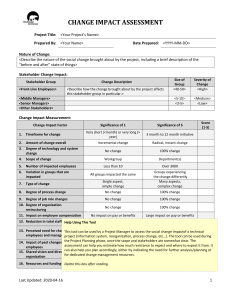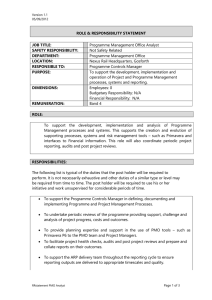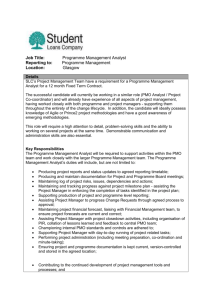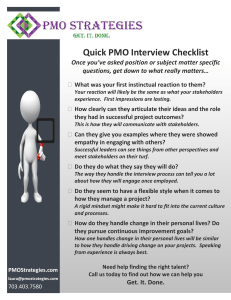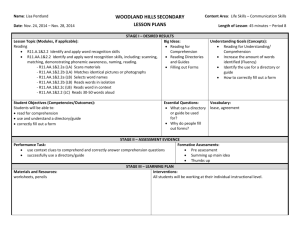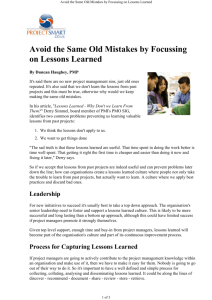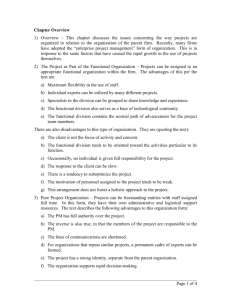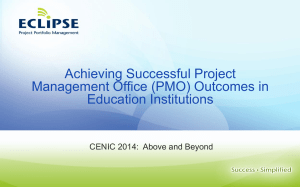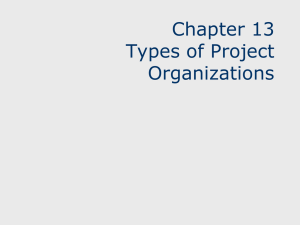Why culture?
advertisement
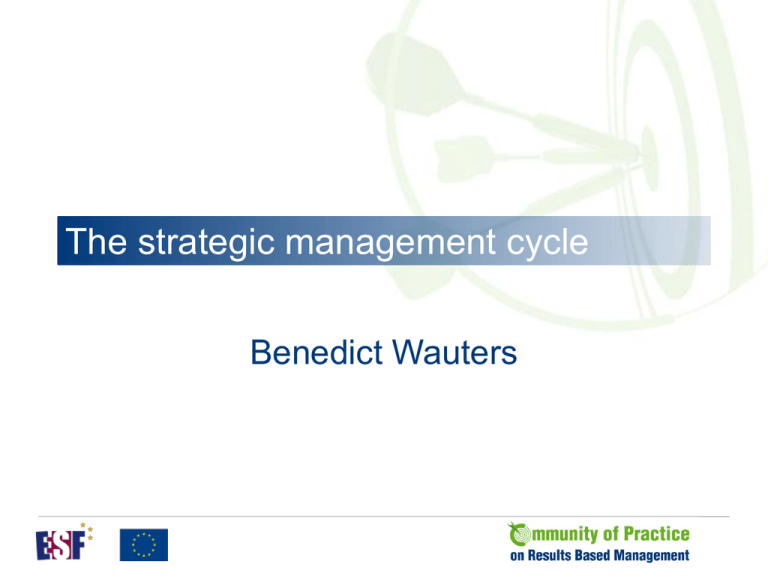
The strategic management cycle Benedict Wauters Six core RBM practices • 1. Orientation of the PMO (programme management organisation) is clear • 2. The PMO strategy is reflected in a strategic results framework • 3. The strategy is translated into operations • 4. Performance information is collected and supplied • 5. Performance information is used • 6. External stakeholders are involved in all aspects 2 1. Orientation of the PMO (programme management organisation) is clear 4. Performance information is collected and supplied 2. The PMO strategy is reflected in a strategic results framework 5. Performance information is used 3. The strategy is translated into operations 3 The strategic management cycle: mission, values and vision Benedict Wauters 5 Belief systems Boundary systems Risks to be avoided Core values, mission, vision Strategy (plan) Strategic uncertainties Interactive control systems Critical performance variables Diagnostic control systems 6 Mission and values of the entity • E.g. “We support – with EU and national resources – organisations to initiate actions that improve the functioning of the labour market. We acquire and share knowledge to contribute to solutions for today and tomorrow.” • E.g. “customer focus: staff have an open and caring attitude, towards project promotors as well as other stakeholders. The promotor can easily get in touch and communicate smoothly with staff. The relation with stakeholders is based on mutual respect and appreciation. Agreements and promises are kept. All interests are taken into account. All of these aspects lead to a relationship of trust.” 7 8 Example of expanded vision Going beyond current capabilities is crucial! 9 Vision can have many different aspects • the ambition can be broad, generic e.g. drive innovation in the labour market e.g. be champions of simplification e.g. • …or it can relate to specific thematic policy challenges high on the political agenda at a give time e.g. improve the life of Roma… e.g. tackle poverty… • if ambition is too low or perceived to be irrelevant as it does not connect with the policy context, those who decide on its mandate may attack it 10 Vision and current operations • When current operations are a mess… • … then vision becomes a vision of survival: how to keep the boat from sinking! • This reaffirms the importance of systems thinking for your current operations: If daily work life is a struggle for survival… …then senior managers coming along with wonderful statements about vision, mission and values are bound to be seen as coming from another planet 11 Warning! • Mission, values and vision can be actively used to drive out critical voices, thus eradicating diversity in the organisation which is problematic for accountability as “robust, resilient and adaptive” • The idea is to foster “a community of inquirers”: practitioners start from their own day-to-day experience of trying to do the work, within the framework of a mission and a vision, but where the aim is to make subjective experience more objective through reflection and discussion with the manager and others in doing so the practitioner and manager could open themselves up to different ways of working and perhaps move themselves on from stuck and less productive ways of working with peers • This entails that what the mission and the vision “mean” at a practical level is constantly being (re)invented 12 The strategic management cycle: culture Vladimir Kvaca Why culture? There three things that influence our „mental software“ – the way we think and behave 1. Being homo sapiens • Universal, shared by all people • Inherited via DNA 2. Culture • Shared within a social group of people • Learned via socialization 3. Personality • Individual for each person • Partly inherited, partly learned The function of organizational culture: The way in which the members of an organization relate to: Each other Their work The outside world in comparison to other organizations. Definition of organizational culture: There are no good or bad cultures. Cultures are functional or dysfunctional depending on who we want to be = what is our strategy. Culture only exists by comparison. Culture has no meaning by itself Assessment of organizational culture • To answer the question if current organizational culture fits the strategy, you need a tool for organizational culture diagnosis. • As culture exists only by comparison, you need to use culture model that has also available database of organizations‘ scores for comparison. • There are several models on the market, e.g.: The Hofstede Model of Organizational Culture Daniel Denison’s model Fons Trompenaars‘ model 17 The Hofstede Model consists of 8 dimensions D1: Means versus goal oriented We identify with the “how” versus we identify with the “what” (Health risks versus effectiveness) D2: Internally versus externally driven We know what is best for the client or we don’t need to care about them versus we do whatever the client wants D3: Loose versus tight work control (Innovation and/or unpredictability versus efficiency/planning) D4: Local versus professional We identify with our direct boss and/or with our work group versus we identify with our profession and/or with the content of our work (Work life is a dangerous affair versus we love to find out what is happening in the rest of the world) D5: Open versus closed systems Newcomers are welcome versus they first have to proof themselves D6: Employee versus work oriented Management takes co-responsibility for the welfare of their people versus management believes that if they don’t put their people under pressure nothing will happen D7: Degree of leadership acceptance from low to high D8: Degree to which people identify with their organization from low to high Please note: - The definitions define the extreme positions - The combinations of dimensions will define well known topics, e.g. D1 and D2 together define process versus result orientation And D1 and D5 together define open versus closed communication. Notes to the dimensions • Culture scores of dimensions 1, 3 and 5 tend to differ within organisation (different units can have different culture with regard to this dimensions) • Culture scores dimensions 2, 4, 6 tend to be the same across the whole organization. • Dimensions 7 and 8 are „semiautonomous“. 20 On-line application to explain the dimensions • http://geert-hofstede.com/culture-andstrategy.html 21 The link between national and organizational Organizational Culture culture Symbols The Hofstede Model While national culture has very slow dynamics (small changes between generationsl), the organizational culture can be intentionally changed in 1-4 years. National Culture 6-Dimensional Model Heroes Rituals Values Practices How the culture change using the Hofstede model works 1. Culture scan (getting the data on current culture) This consists of quite simple data gathering, survey for the staff (40 minutes) and two short surveys for the management. 2. Discussion with the management, which culture should be optimal for the organization. 3. Comparison of actual and optimal scores 4. Identification of priorities for change 5. Planning the change 6. Actions to change the culture 23 Example on the case of National Coordination Authority • • Culture scan conducted at the end of July 2014. Optimal scores presented in the example are preliminary, still need to discuss with other managers. 24 25 Some main conclusions • Strengths are our profesionalism, ability to learn and identification with the organisation. • There is a high danger of burn-out, some people are stretched over their limits • We are „functional bureaucracy“ • We don‘t care enough about our „customers“. 26 27 28 29 Change • Changing people’s ways in organisation on purpose can be realised in two ways: • Directly by tell and sell • Indirectly by changing people’s work environment to such a degree that they would be stupid not to adjust their behaviour Readiness for change is also dependent on culture, it is connected to feelings of trust and security and 30 Why to care about your (organizational) culture • By understanding your culture, you can predict what is more likely to work in your organizations and where you can expect problems. • You should be careful when trying to implement „best practices“ from other organizations (or even countries) – shouldn‘t you change your culture first? 31 The strategic management cycle: from SWOT to strategy maps and cascading objectives Benedict Wauters 33 Example output of a SWOT exercise What are key strategic priorities? Eg what S can we use to capture O? What W must we amend? Etc. Once, again, if current operations are mess, this will crowd out any thinking about longer term opportunities and threats 34 • A key question here is to define how you want to add value as a PMO? • We will cover this when we discuss delivery mechanisms! 35 PMO strategy = strategy concerning added value OP Priority 1 OP OP Priority Priority 2 3 PMO strategy = technical assistance priority Added value by leveraging the technical assistance! OP Priority 1 OP Priority 2 OP Priority 3 PMO strategy = technical assistance priority 36 37 Strategic results framework: recap The results framework focuses on PMOs and what these organisations should be changing to increase their added value to a country or region. The top level reflects policy challenges. But the PMO strategy will not typically emphasise all thematic context objectives, only those that pose a real challenge to the PMO and its existing way of working, and may add other types of expectations to/ from policy-makers. Expectations in different perspectives are bi-directional (toward and from) 38 Example of expanded vision Same vision can be realised with different strategies! 41 Innovator strategy map vs enhancer 42 WARNING: remember that the function of objectives here is to create opportunitz space as it is an interactive control sźstem while most use it as a diagnostic szstem Hence learning objectives probablz fit better here. Belief systems Boundary systems Risks to be avoided Core values, mission, vision Strategy (plan) Strategic uncertainties Interactive control systems Critical performance variables Diagnostic control systems 43 CORPORATE MAP -Focus on synergies (coordination and cooperation ) -Focus on common priorities/principles -…or fix completely BU maps (then BU maps are the same) BUSINESS UNIT MAP Focus on core value adding processes BUSINESS UNIT MAP Focus on core value adding processes 44 INTERACTIVE CASCADING Belief systems Boundary systems Risks to be avoided Core values, mission, vision Strategy (plan) Strategic uncertainties Interactive control systems Critical performance variables Diagnostic control systems 45 Cascading • From the business unit strategy is cascaded to operational teams within the business unit • They should conduct a mission, vision and values exercise at their own level, within the framework of the higher level ones, and then to look at the higher level strategy map from that perspective this may lead to requesting adjustments to the higher level map or to adjusting mission, vision and values most frequently unit level mission, vision and values will just be helpful in translating a higher level map into a suitable lower level one. • The strategic outputs and outcomes on the map are arrived at in consultation with staff in the cascading process The business unit strategy may therefore be adjusted in the cascading process • The idea is that there is a discussion where a lower level can argue for its interpretation of a higher level map and can even argue for modification of the higher level • Contestation is very much at the core of this process and it is crucial that higher level management incites this and creates openness for it Within operational business units, individual staff member objectives are then similarly aligned to unit objectives but be careful here 46 Regulatory/Support unit alignment • Regulatory/Support unit strategy map should have: a top level with a focus on both effectiveness (this contains the objectives from the corporate, business and operational unit maps that the support unit can impact on) and efficiency (in terms of use of resources) a client level that identifies who the units serve and what these clients (or client groups, e.g. staff, managers, ...) expect an internal process level an internal capacity level 47 The strategic management cycle: strategic initiatives, improvement projects and planning operations Benedict Wauters Skip for now 49 Strategic initiatives • The vision relates to the next 3-10 years. Hence so does the strategy. This entails the strategy map is future oriented. • If the vision was challenging enough (as it should be) then it would be hard to imagine that this can be realized by doing more of whatever the entity is already doing or by doing it better with whatever means it is already using. • Rather, the entity will have to do things it does not do yet at all or acquire new capacities, competences and/or relationships it does not have yet. 50 Strategic initiatives • Strategic initiatives do not represent: business as usual or … ongoing improvement/maintenance of existing processes and outputs • They proactively prepare the organisation for the future e.g. by addressing NEW products/services via new (types of) calls for proposals …and/ or NEW relations, competences, expanded capacities hence there is considerable uncertainty about how to run them and what they can achieve • E.g. a full Vanguard method based redesign • Require coordination from many parts of the organization • As some strategic initiatives may be related (complementing each other or feeding each other), they should be grouped under overarching themes that can be visualized in the strategy map. 51 52 * Quality of care: solve my health issues in a sustainable way as quickly as possible 1.Select a process objective *illustrative real example not be taken as an ideal example 53 2. Break up the process objective into its key components THREE MAJOR TRANSACTION POINTS OF CONTACT THAT FEED INTO EACH OTHER 54 3. Break down the components into drivers To understand better what the situation is, you can engage in measurement 55 4. Reflect on what the measurement tells you from a systemic point of view Use continuous improvement with inline experimentation. Be careful with measures: should be “systemic”. When major redesign required with new capabilities, it is a strategic initiative rather than improvement. *illustrative real example not be taken as an ideal example 56 57 Strategic versus operational plans P L A N S B U D G E T Strategic initiatives Demand plan: planned (increase of) outputs by type (ranging from simple outputs to complex calls for proposals) Factoring in expected process improvements Capacity requirements + free capacity maintained (in % used of available people and facilities) STRATEX (can be both expenses or capitalisa tion) Direct operational, maintenance AND improvement costs = OPEX Indirect operational cost =OPEX Capital expenditure (replacement/expansi on of existing facilities for current business) =CAPEX Operational plans (with a one year time horizon) specify which outputs will be delivered by which parts of the entity. Remember! This concerns planning and score keeping, NOT operational management (developing, improving we do with szstems measures)! 59

